Disclaimer: This post contains affiliate links. At no cost to you, I might earn a small commission if you make a purchase through the links in this article.
Capitol Reef National Park is a spectacular and yet the least visited of all national parks in Utah that boasts superb hikes and none of the crowds. That alone should make you jump at the opportunity to visit, but if you are still wondering about it, keep on reading.
I visited Capitol Reef after making stops at four other Utah National Parks, and regretted that I didn’t do it sooner. Capitol Reef offers mind-blowing landscapes and cool hiking trails that meander through narrow slot canyons and take you to scenic vistas that only a few people get to see.
Read: Is Salt Lake City worth visiting?
Although many visitors drive through Capitol Reef on their way from Bryce Canyon National Park to Moab (or the other way around), this national park deserves more time on your Utah itinerary.
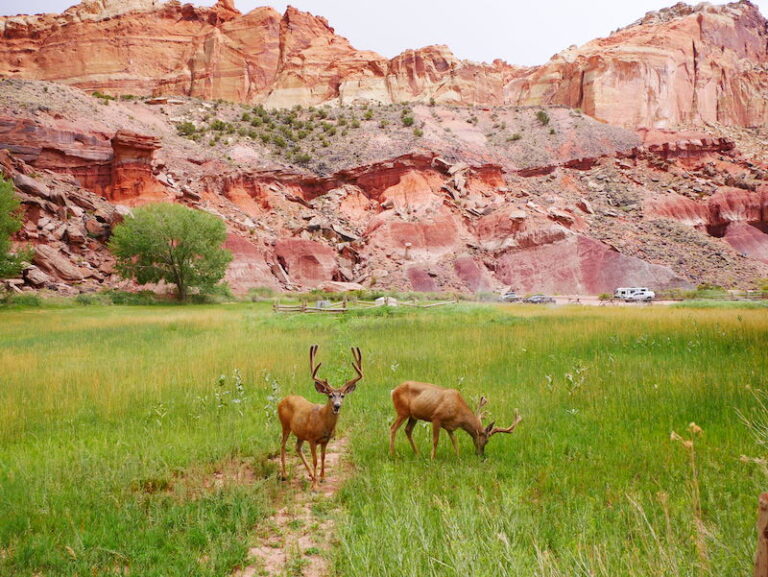
Spending a day at Capitol Reef is an option if you are a short on time, but the best way to explore Capitol Reef National Park is by spending a couple of days here.
In this article, I will explain how to get to Capitol Reef, provide an overview of some of the best hikes in Capitol Reef for all levels, explain where to stay in Capitol Reef and where to grab bite after you are done hiking, so you can plan your adventure.
Where is Capitol Reef National Park?
Capitol Reef is one of the most impressive national parks in Utah in south-central part of the state. The park is located in the heart of Utah’s red-rock country and is dominated by impressive sandstone domes, cliffs and tall canyons.
Best things to do in Capitol Reef National Park: an overview
Before you start planning your trip to Capitol Reef National Park, let’s go over some of the park’s highlights. This will help you to plan your adventure and better understand how and where to spend your time at this national park.
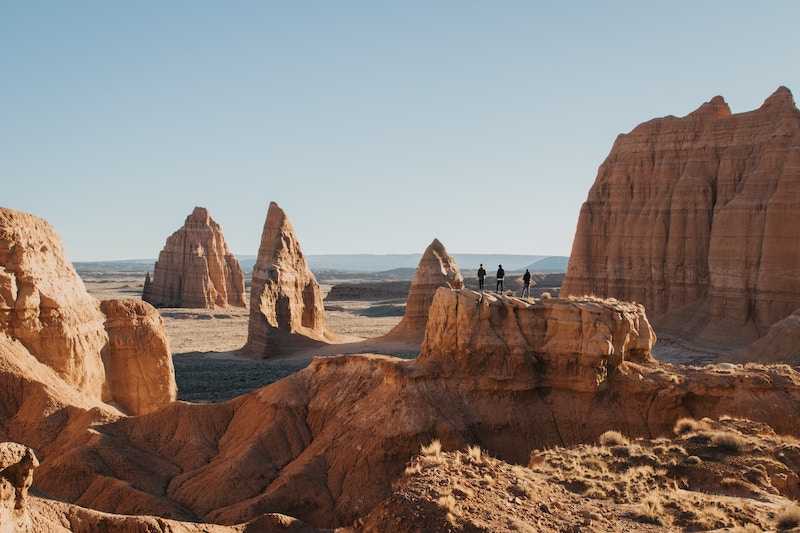
1. Camp at Cathedral Valley District
Camping is one of the best things to do in Capitol Reef, and the remote Cathedral Valley District is the top place for it.
This rugged district dominated by the three sandstone monoliths is located in the northern part of Capitol Reef National Park. The Cathedral Valley Loop that runs through the district spans for 58 miles and takes an average 4-5 hours to drive around.
To get to Cathedral Valley District, you will need a 4X4. Since the drive is pretty long, I recommend camping there, especially if you want to capture magical sunrise over the valley.
✅ CLICK HERE TO RENT A 4X4 TO VISIT CATHEDRAL VALLEY DISTRICT
How to get to Cathedral Valley
To access Cathedral Valley, you can use one of three access points. I will provide more details about distances and important locations in the “Tour” section, but here is how to get to them:
- River Ford – Get off Utah 24 about 2.7 miles east of the park boundary, onto a dirt road that reaches the Fremont River in less than half a mile. You will get on Hartnet Road, which leads about 33 miles to Cathedral Valley Junction in Upper Cathedral Valley, but you will need a high clearance vehicle for that.
- Caineville Road – Get off Utah 24 onto a signed dirt road about 9.5 miles east of the park boundary. This road leads about 26 miles to Cathedral Valley Junction in Upper Cathedral Valley and also passes Lower Cathedral Valley.
- Last Chance Road – Take Exit 91 off Interstate-70 and follow the main trunk road for 27 miles. Make sure to download an offline map, if you decide to go this route, as many parts of the road are intuitive and signage is not very good.
2. Learn history through Fremont Petroglyphs
One of the coolest things about Capitol Reef National Park is that you don’t have to hike for hours to see the historic petroglyphs.
You can actually see some incredible historic wall off the main road less than 5 minutes away from the visitor center. All you need to do is to find a designated parking and proceed along the wooden boardwalk.
3. Enjoy the views along Highway 24
Highway 24 is the main road in the Capitol Reef that runs east to west. Although it is about 16 miles long, it definitely feels a lot longer mostly because of the awesome scenery along the way.
If you are driving from the east you will first see massive red walls with cliffs and star drop-offs. When you pass Capitol Reef Visitor Center, and arrive in Torrey, the scenery will give way to sprawling mesas with quirky rock formations and high desert vegetation.
4. Drive on Loop the Fold
Exploring Waterpocket Fold, the ancient geologic formation, is one of the best under-the-radar things to do in Capitol Reef National Park.
Loop the Fold is the road that takes you around water pocket fold and begins at the Notom Bulllfrog Road before the entrance to the park. Unlike Cathedral Valley, you can do this drive in a regular car, but, during winter or monsoon season, a 4X4 is necessary because the road is unpaved.
The drive boasts variety of cool slot canyons along the way some of which are very easy to reach such as Surprise Canyon and Headquarters Canyon.
If you drive the entire loop, you will arrive at Burr Trail Road with a series of switchbacks leading to incredible overviews. I recommend taking a hike to Strike Valley overlook from where you can enjoy panoramic views of the area.
This is by far one of the most remote areas of the Capitol Reef National Park, where very few visitors go and it makes for one of the most wonderful experiences as you will have most of the trails to yourself.
If you plan on spending your day in this part of the park, bring plenty of water, snacks and a map.
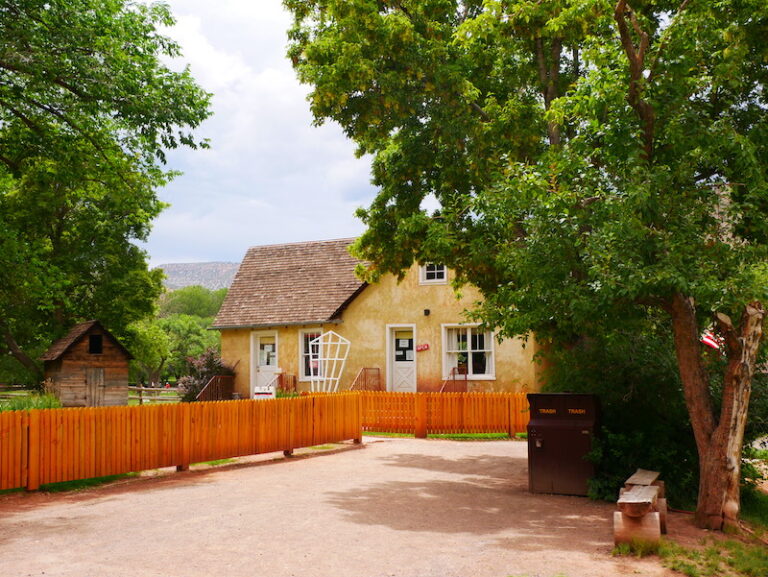
5. Make a stop in Fruita
Regardless of how much time you plan to spend in Capitol Reef, you will drive through the historic Fruita District (one of the three districts in Capitol Reef, with Cathedral Valley and Waterpocket Fold being two others).
The center of the Fruita District is Fruita, a historic town that was a home of early Mormon pioneers who settled in this remote part of Utah. Here you will find the only campground in Capitol Reef, get to see the historic Fruita barn and try delicious pies and sweets at Gifford House.
6. Pick fruits at Fruita orchards
One of the best things to do in Capitol Reef National Park is picking fruits in the Fruita orchard!
There are many fruit trees and from spring to early fall you can pick cherries, apricots and apples for free or for a nominal fee. When I was visiting the orchard, there was also a group pf horses right nearby which was really cool.
7. Take Capitol Reef Scenic Drive
Another highlight of Capitol Reef, this 8-mile scenic route begins in Fruita and ends near Capitol Gorge Road showing you some of the most incredible views along the way. If this is your first visit to Capitol Reef, allow extra time because you will most likely will want to pull over and take some photos.
8. Enjoy sunset from Sunset Point and Goosenecks Overlooks
After you spend your day hiking and exploring Capitol Reef, head over to Sunset Point and Goosenecks overlooks, a cool vista that can be reached via a short trail from the parking lot accessible via gravel road.
While Sunset Point is just a short walk up the hill, Goosenecks overlook is about 0.3 miles away and can be reached via dirt trail. Plan to spend about 30-40 minutes here to take in the views before heading back to your hotel or campground for the night.
Watching the sunset from this place is one of the best things to do in Capitol Reef to wrap up your day.
9. Check out Waterpocket Fold
Capitol Reef National Park is home to water pocket fold, an impressive rock formation and the most defining feature of the park that formed millions years ago.
This “wrinkle” spans over 100 miles through the park and creates a stunning landscape of red-rock cliffs, mesas, domes and canyons.
How to see Waterpocket Fold
The only paved road in the park that allows to see Waterpocket Fold is Highway 24. You can also see the fold by hiking the Burr Trail along the Notom Bullfrog Road that runs parallel to the fold.
The erosion of watrepocket fold continues to this day, in fact, the word water pockets is referred to the many basins that have formed in sandstone layers eroded by water. Since these basins are common throughout the area, hence the name, water pocket fold.
Exploring this area is one of the best things to do in Capitol Reef National park off the beaten path!
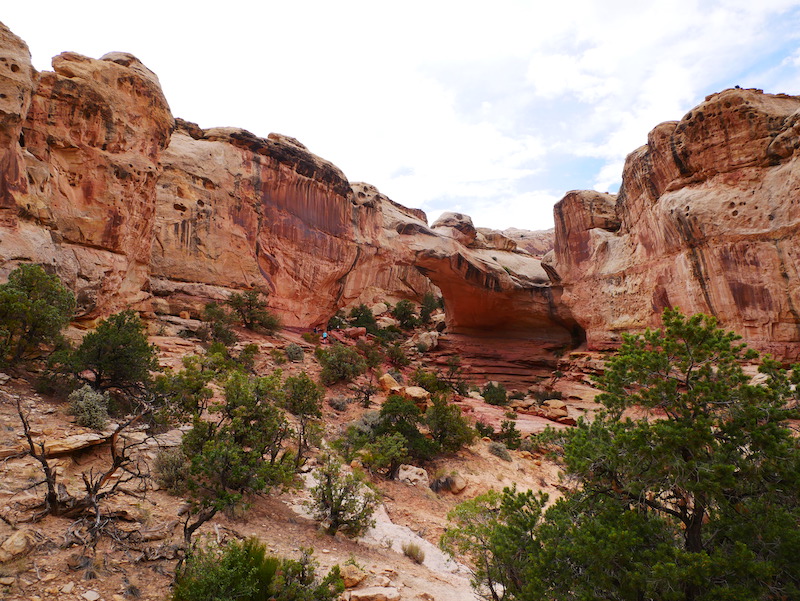
Best hikes in Capitol Reef National Park
Most visitors know Capitol Reef National Park thanks to a handful of highlights such as the Fruita Barn, Capitol Reef Scenic Drive and the ancient petroglyphs, but there are so many things to do in Capitol Reef National Park aside from that.
During my visit to Capitol Reef National Park I kept wondering about why this park doesn’t see more visitors. Many hikes at Capitol Reef National Park that I took were refreshingly uncrowded compared to busy places like Arches or Zion.
1. Cohab Canyon
Length: 3.4 miles
Difficulty: moderate to strenuous
Surprisingly few people know about Cohab Canyon, and yet, this is one of the best hikes in Capitol Reef National Park. The trailhead to Cohab Canyon takes you right above Fruita and begins near the main road. Since the hike is a bit steep in the beginning, it’s better done from March through October when the trail is clear from snow.
2. Cassidy Arch
Length: 3.4 miles
Difficulty: moderate
Cassidy Arch is one of the best hikes in Capitol Reef National Park, but there are a few things to know since the trail runs through the deep canyon.
I made a mistake when I was trying to hike Capitol Reef National Park in late July and started my hike at noon and had to turn around about half way because of the flash flood warning.
What to know about hiking Cassidy Arch in Capitol Reef
If you want to visit Capitol Reef in summer, be aware of the monsoon season that lasts mid-to-late July through September and often brings torrential rain in the afternoon making it dangerous hike through narrow slot canyons.
Unfortunately, Utah National Parks and surrounding areas see deaths almost every year during this time, because many visitors are unaware of the dangers that come with flash floods.
To avoid the monsoon season, do this hike in September or early October or early summer when temperatures are still mild and the sunshine is plentiful.
The hike to Cassidy Arch will take you 400 feet above the Scenic Drive and the nearby Grand Wash Trail.
3. Hickman Bridge
Length: 1.8 miles
Difficulty: Easy
One of the best easy hikes at Capitol Reef National Park, Hickman Bridge is a perfect option if you don’t have a lot of time. The trailhead begins at the parking just a few miles down from the Capitol Reef visitor center. Be sure to arrive early, as the trail can get busy by late morning/early afternoon.
4. Navajo Knobs
Difficulty: strenuous
Length: 9.5 miles
One of the most strenuous hikes at Capitol Reef National Park, Navajo knobs gains a whopping 2,100 feet of elevation, so prepare plenty of water and snacks for your hike! The trail first takes you to Rim Overlook and continues from there to one of the best panoramic overlooks in the entire park.
5. Capitol Gorge Trail
Difficulty: Easy
Length: 1.5 mile
This easy trail is perfect retreat on a hot summer day thanks to plenty of shade created by the steep canyon walls that surround it. Here, you can also see the famous Pioneer Registry, or the historic graffiti with the names of early settlers who came here in late 18th century.
To reach the trailhead, you will need to take Capitol Reef’s Scenic Drive all the way to the end.
6. Grand Wash Trail
Difficulty: Easy
Length: 4.8 miles
One of the most impressive (and underrated) hikes in Capitol Reef National Park, Grand Wash takes you through a huge canyon that gets more and more narrow as you keep going. While you can hike the entire length of the canyon, you can also turn around and go back at any point.
7. Combine Grand Wash with Cassidy Arch and Frying Pan
If you have extra time, hike a stunning 10.4 mile loop trail that offers some of the best scenery of the park. While the majority of visitors choose shorter hikes, this trail offers the taste of the ultimate adventure as you will see few people and will be able to enjoy jaw-dropping landscapes all around you.
8. Sunset Point
Length: 0.8 miles
Difficulty: Easy
As the name suggests, Sunset Point is the most popular spots in Capitol Reef for catching the sunset and the trail leading there is super easy. You don’t have to wait until the evening to come here because the views at this spot are fantastic at any time of the day.
I recommend combining Sunset Point with a 0.2-mile Goosenecks overlook trail right nearby. These are the best easy hikes at Capitol Reef National Park
9. Chimney Rock
Length: 3.6 miles
Difficulty: Moderate-to-strenuous
One of the less known hikes in Capitol Reef National Park, Chimney Rock trail takes you above the stunning bright red valley and into the canyon. The hike has a steep ascent that leads you to a flat mesa and flattens out after that. The highlight of this hike is the tall chimney rock near the side of the canyon wall.
10. Cathedral Trail
Difficulty: Easy
Length: 2.5 miles
Cathedral trail is one of the best hikes in Capitol Reef National Park that offers superb views of the giant sandstone towers in the Cathedral Valley.
The trail culminates at the top of the hill from where you can get a nice overlook of the entire valley. If you can get up early, do this hike before the sunset to catch the amazing glow of the sun over the valley.
Where to stay near Capitol Reef National Park
Capitol Reef doesn’t have any hotels inside the park, but there are a few hotels in Torrey, a small town at the western entrance. There are also a couple of accommodations in Loa, a tiny community west of Torrey.
Best Hotels in Torrey Utah
- Capitol Reef Resort is a good option if you are looking for great amenities and excellent food available at a restaurant on site.
- Austin’s Chuckwagon Motel a less expensive hotel further away
- The Noor Hotel a popular option at the edge of the Capitol Reef National Park
- Sand Creek Cottage has private parking, kitchen and home-style feel about 18 miles from the park.
Camping in Capitol Reef
If you want to see the clear dark skies, camping is one of the best things to do in Capitol Reef National Park. Fruita Campground is the only campsite within the park, limited to 71 sites with no hook-ups that can be reserved online.
Torrey also has several campgrounds, like Sandcreek RV Park on the outskirts of Torrey and has spots for RV’s and tents.
Cedar Mesa Campground is a primitive campground with fewer spots in Torrey, and Wonderland RV Park is the most popular option for RV’s and campers thanks to amenities such as restrooms, showers and laundry.
America The Beautiful National Parks Pass
If you plan on visiting Capitol Reef, there’s a good chance you will also visit other National Parks in Utah. Get America The Beautiful National Parks Pass which costs only $80 and can be purchased at any national park or online.
PRO TIP: Download an offline map of Capitol Reef National Park ahead of your visit or grab a paper map at the visitor center. Cell phone service is non-existent in many areas of the park, and you will not be able to look up directions or check anything online.
How to get to Capitol Reef National Park
The closet major airport to Capitol Reef National Park is 221 miles away (about 3,5 hours) in Salt Lake City (SLC). You can also fly to Harry Reid International Airport in Las Vegas (LAS), which is 267 miles from Capitol Reef National Park, since it’s a convenient starting point to all national parks in Utah.
Check: Best Things to Do In Las Vegas Besides Gambling
The most visited area of Capitol Reef National Park is the Historic Fruita District, roughly 20 minutes east of the town of Torrey along Highway 24.
Distances from Capitol Reef to other national parks in Utah
- Bryce Canyon National Park: 112 miles, 2 hours 10 minutes
- Arches/Canyonlands National Parks in Moab: 140 miles, 2 hours 15 minutes
- Zion National Park: 176 miles via Interstate-15 south
Renting a car for your trip to Capitol Reef National Park
To visit Capitol Reef National Park as well as other Utah national parks, you will need a car. If you are looking for an RV, check out RVshare, a website with a great selection of all sorts of RVs, and if you are looking for a regular car, book it on DiscoverCars, one of my favorite websites for car rentals.
➡️ CLICK HERE TO RENT A CAR FOR YOUR TRIP TO CAPITOL REEF
How long does it take to drive through Capitol Reef National Park?
The Capitol Reef Scenic Drive is a 7.9 mile paved road. It tales about 1,5 hours to drive the Scenic Drive and the two dirt roads Grand Wash and Capitol Gorge that spur off.
Best restaurants in Capitol Reef National Park
You will probably get a little bit hungry toward the end of the day after enjoying some of the best things to do in Capitol Reef National Park. There are several restaurants in Torrey from Subway to a couple of good sit-down eateries.
- La Cueva Restaurante – a classic Mexican restaurant with a good variety of items aside from tacos and burritos. If you are a vegan or vegetarian, this place is a must stop, as awesome people in the kitchen can modify some dishes by taking out meat and cheese.
- The Rock Garden Eatery and Bar – a great option for breakfast, lunch and dinner, the Rock Garden Eatery in the Red Sands Hotel has tons of options on their fresh farm menu. This place boasts rave reviews and great atmosphere, so consider checking it out.
- Chak Balam Mexican Restaurant – located on the outskirts of Torrey, Chak Balam is a small restaurant near Sandcreek RV Park. The menu offers enchiladas, fajitas, nachos, burritos and relleno among other dishes. This place is worth a stop if you want delicious Mexican food.
Best time to visit Capitol Reef by seasons
If you plan to spend time and hike in Capitol Reef, you need to know that each season comes with distinct weather conditions that could affect your ability to enjoy the park. Mid-to-late spring and early fall are the best seasons for hiking in Capitol Reef if you re looking for perfect temperatures and smaller crowds.
Below is an overview of the different seasons in Capitol Reef National Park
- Summer – The busiest time in Capitol Reef, with July and August being the hottest months in Capitol Reef when temperatures often climb to high 90’s. For better experience, plan your activities around early morning or late afternoon, so you can avoid the mid-day heat.
- Fall – Late September through October are the best months to visit Capitol Reef, thanks to mild temperatures, thinner crowds and spectacular fall colors. September is when the harvest begins in the Fruita District, and you can pick up some apples if you pass by.
- Winter – Winter in Capitol Reef is the slowest time when it’s not uncommon to see below-freezing temperatures. The main advantage of visiting Capitol Reef during winter months is the opportunity to enjoy the views of the stunning red rock country powdered by snow, but your hiking options could be limited as many trails get covered by snow and ice, particularly at higher elevations.
- Spring – While early spring in Capitol Reef could be still chilly, mid-to-late spring offers perfect conditions for hiking and spending time outdoors before the peak season begins.
Things to do in Capitol Reef National Park: FAQ’s
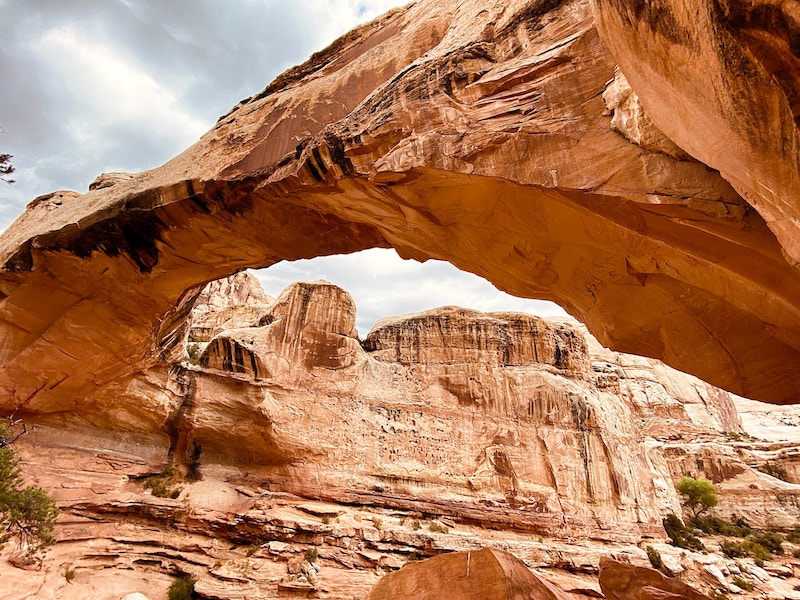
What is the closest town to Capitol Reef National Park?
The closest town to Capitol Reef National Park is Torrey. Here you can find a few hotels, campgrounds, restaurants and stores.
How many days do you need for Capitol Reef National Park?
Plan to spend 2-4 days at Capitol Reef National Park. Two days is will allow you to enjoy some of the best things to do in Capitol Reef, do popular hikes like Cassidy Arch, Hickman Bridge and leave enough time for one strenuous hike.
Four days is a good amount of time if you are looking to get outside the beaten path and explore Cathedral Valley District, drive Loop the Fold and do a combination of longer hikes at the park.
What is the best season to visit Capitol Reef National Park?
The best time to visit Capitol Reef National Park are May and September through October. These month offer the best weather for hiking and camping and the crowds are thinner than during summer months.
June through August is the busiest time in Capitol Reef and the monsoon season lasts from mid-July through early August, affecting hiking conditions. Mid-to-late fall and winter are much slower in Capitol Reef due to colder temperatures, when many hotels and restaurants in the area close for the season.
Is Capitol Reef worth visiting?
Capitol Reef is one of the most beautiful places in Utah, and a perfect place to escape the crowds. The park is an outdoor playground where you can hike scenic trails, get a glimpse into the history of Utah and learn some interesting geology.
Cool places to visit near Capitol Reef National Park
One of my favorite places to visit near Capitol Reef National Park was Goblin Valley State Park. This underrated state park sits east of Capitol Reef, about 30 minutes north of Hanksville. Goblin Valley has several easy hikes, but it can be extremely hot in summer, so bring water, sunscreen and hat because there are no stores and facilities are limited.
How to spend one day in Capitol Reef?
If you have only one day at Capitol Reef National Park, you can do a combination of scenic overlooks and easy-to-moderate hikes such as Cassidy Arch, Hickman Bridge or Cohab Canyon in the morning.
Make a stop in Fruita to explore the historic district and try delicious pies at the historic Gifford House and drive through the park to enjoy the scenery and learn about the park’s history through petroglyphs and the geology of the Water Pocket Fold.
Head over to Sunset point to round up your day to relax and catch the colors of the setting sun – you can still enjoy some of the best things to do in Capitol Reef, even if you have limited time.
Best things to do in Capitol Reef National Park: final word
Located away from the major travel route, Capitol Reef is one of the least visited national parks in Utah. It boasts wonderful hiking trails, clear dark skies and some of the best scenery. Make sure to add this national park to your Utah itinerary!
